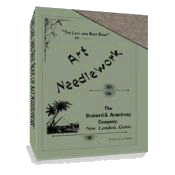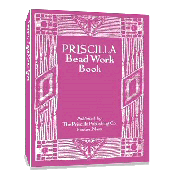Patchwork
What it Is and How to Use It
Patchwork has been around for a very long time. It can be one of the most beautiful artistic endeavors a needleworker can do. The need for precise positioning as well as accurate cutting and agreeable color combinations is as important today as it was for Victorian ladies who loved this type of needlecraft.
This needlework was the epitome of recycling, something our fore-mothers did way before "recycling" became the house-hold word it is today. Victorians ladies would use cloth from old dresses, house linens or anything else and use it to make patchwork quilts and other beautiful items. Today's living may not provide the abundance of extra fabric to recycle but some women have had the forethought to save their children's clothing and make a quilt for their adult child or for their grandchildren. What history that quilt would bring to the family!
Whether you can recycle or you purchase the materials, patchwork can be a great way to express your creativity, one square at a time.
The below information is fromThe Dictionary of Needlework: An Encyclopedia of Artistic, Plain and Fancy Needlework. 1887, by S.F.A. Caulfeild and Blanche C. Saward 1887. It has been edited for use on this site.
What is Patchwork?
This needlework, which consists in sewing pieces of material together to form a flat, unbroken surface, possesses many advantages, as it is not only useful and ornamental, but forms out of odds and ends of silk, satin, or chintz, which would otherwise be thrown away a handsome piece of work.
Its manipulation requires both patience and neatness, and also calls into play both the reasoning and artistic faculties, as the designs chiefly depend for their beauty upon the taste displayed in the arrangement and selection of the shades of colour used to produce them. Patchwork originally only aimed at joining together any kinds of materials in the shapes they happened to have retained, so that, when arranged, a flat surface was produced; but, at the present time, much more is required from the worker, and the pieces used are selected from the same make of materials, though of varied colours, and are cut into one or several set shapes and sizes, and put together so as to make a design by fitting into each other, both as to shape and shades, and this design is reproduced over the whole area of the work.
The designs so worked out are necessarily geometrical, as it is essential that they should reply to fixed and accurate measurements, and the figures selected are the angles formed by squares, diamonds, and hexagons, in preference to the curved lines formed by circles and ovals, as the joining together of ovals and rounds in perfectly correct patterns is much more difficult to accomplish than when points are fitted into angles, as is done with the first-named figures.
Uses of Patchwork
Patchwork, when completed, is used for many purposes, and is made of velvet, satin, silk, leather, cloth, cretonne, twill, and chintz; in fact, of any material sufficiently soft to be cut into set shapes, and to bear a needle through it. Velvet and satin form the handsomest kind of work, and brocaded silks mixed with plain silks and the next, Satin and silk are not used together, but velvet can be used with either. Cloth should be used by itself; cretonne, twill, and chintz, together or alone. It is not judicious to use a material that requires washing with one that will keep clean, but this is often done. Satin, silk, and velvet
It is used for cushions, hand-screens, fire-screens, glove and handkerchief cases, and pincushions; cloth Patchwork for carriage rugs, couvrepieds, and poor people’s quilts; cretonne, twill, and chintz for couvrepieds, curtains, quilts, and blinds. These larger articles require a greater amount of material than can be collected from private sources, but large silk mercers and linen drapers sell bundles of pieces by the pound.
The working out of the design, and the manner of making up the patches, are the same, whatever the material or size of the article, the difference being made in the size of the patches used, they being increased or decreased for the occasion. The great essential is that every piece should be cut with perfect uniformity, and the use of a thin plate of tin, cut to the size required, is therefore recommended; the other requisites are old envelopes and letters, or other stiff pieces of writing paper, the patches, and sewing silk or cotton matching the patches in colour, with which to sew them together.
Manner of Working
The manner of working is as follows: Select the design to be copied and the shades of material, have a piece of tin cut out to correspond with each shape to be used, and lay this upon the silks or satins, and outline round with a pencil. Cut out the shapes larger than the outline, to allow of turning in the raw edges, and divide of the various pieces, keeping together all of one shade and all of one form. Then cut out upon the paper the exact outline of the tin plate, leaving nothing for turnings. Tack the paper and the silk piece together, turning the raw edge of the silk over the paper, and Tacking it down so as to keep it from fraying out while working. Arrange the patches thus made on a table, according to the design and the position each is to occupy as to colour; take up two that are to be close together, turn the silk sides inwards, so as to stitch them together on the wrong side, and then carefully stitch them together so that that accurately join point to point, angle to angle. Continue to sew the pieces together until the size required is obtained, then tear the paper away from the silk, and iron the work upon the wrong side. Line it with twill or some soft, smooth material, and if it is required for a counterpane or couvrepied, wad and quilt the lining; if for a mat, handkerchief case, &c., put a ball fringe round it.
So Many Beautiful Patterns!
If you were to list all the patchwork patterns, you would have quite a long list. As with embroidery stitches, many patterns go by more than one name.
I have listed a few of the more popular patterns and have provided the instruction to each that women of the Victorian era followed. See Victorian Patchwork Patterns for those available FREE here at Victorian Embroidery and Crafts.
The Last and Best Book of Art Needlework
Over 100 pages of authentic Victorian instructions and patterns from 1895!
FREE
Beeton's Book Of Needlework

433 pages!
Sign up for VEAC! Everything you wanted to know about Victorian embroidery, needlework, crafts and more!
Priscilla Bead Work Book
Make Beautiful Victorian Beaded Purses, Jewelry & Accessories - Starting
TODAY!



